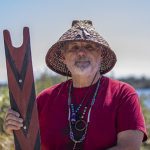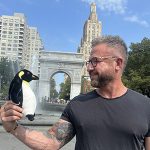An original method
Scientific research is taking place at Clark College, in an unusual way
4-minute read
Shortly after Ridge Bynum ’18 started at Washington State University in Pullman, Wash., he sent an email to a psychology professor who was conducting interesting research, asking to join the research team. For most undergraduate students, such an email would languish in the professor’s inbox or get dragged into the trash.
Bynum got a near-immediate response: “How fast can you start?”
To that professor, Bynum was the undergraduate equivalent of a unicorn. He arrived at WSU with experience collecting data in a scientific research project. He would need very little training, in other words, and could help right away.
“Usually, you’re not doing actual data collection until graduate school,” Bynum said.
Instead, he got hands-on experience at Clark, where he worked as a research assistant for psychology professor Mika Maruyama. Along with a professor at Portland State University, Maruyama designed and oversaw a study to determine whether virtual reality could replicate the health-boosting effects of a pet. Today, Bynum’s name appears as a co-author on a presentation of the study at a 2020 conference of the American Association of Behavioral and Social Science.
Original research
Community colleges are not known for contributing original research to our body of knowledge about the world but that’s exactly what Clark does. Clark professors—and students—are studying how pikas respond to climate change. They’re looking for new antibiotics in soil sampled from ice caves in the crater of Mount St. Helens. They’re testing new methods for teaching science.
And unlike at four-year institutions, where faculty are pressured to publish to earn tenure and raise funds, the research at Clark has a different purpose: helping students learn.
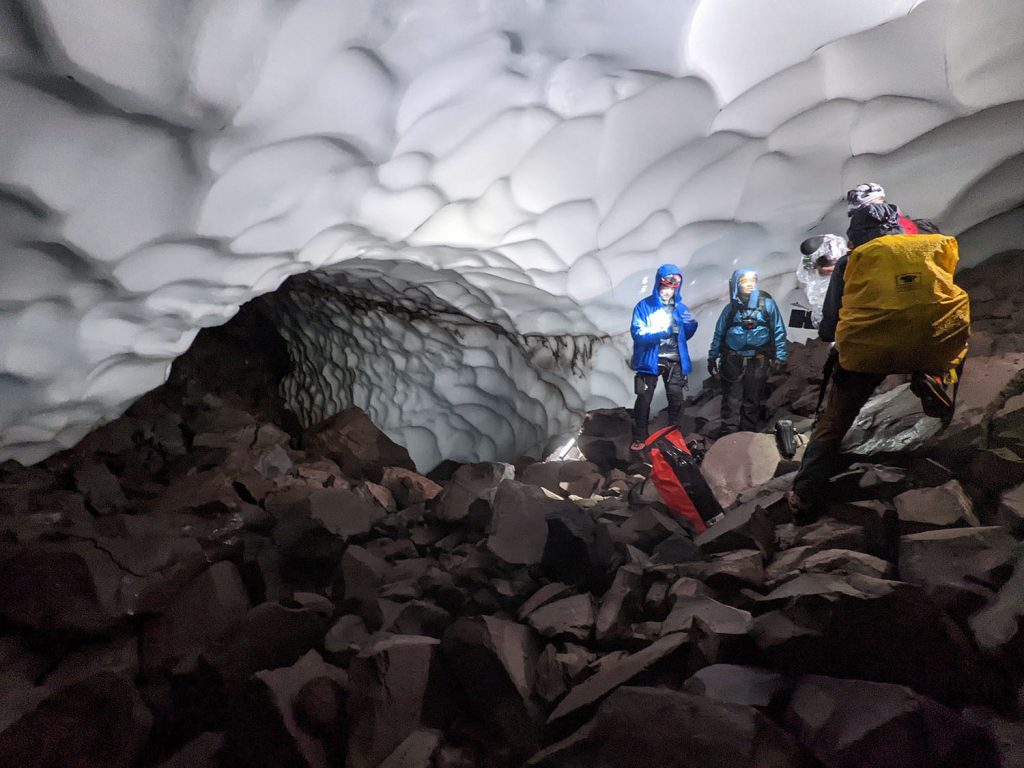
A July 2022 expedition in an ice cave on Mt. St. Helens in Washington. Clark microbiology professor Roberto Anitori is on the left, in the dark blue jacket. He takes samples from this environment for his research. Photo by Rick Davis
Dr. Roberto Anitori, Clark biology professor, said research at a two-year college is treated as an extracurricular activity rather than part of the job description. This creates challenges, such as securing funding. Anitori collects soil samples for two research projects, including one that is the focus of Clark’s Biology 105 course, during the summers when he’s not on contract for Clark. He scrapes together funding, most recently from the Mazamas mountaineering club in Portland, Ore.
On the other hand, the experience is not cutthroat. At a two-year college, people do research because they want to, not because they must do research.
Virtual pets
Maruyama has authored a wealth of publications about human interactions with animals. Initially, she was interested in people who suffer from psychopathology, who tend to have a history of harming animals beginning at an early age. Then she began wondering whether children could learn to be kinder to people by learning to be kind to animals. She studied pets’ physical, emotional and moral beneficial effects on humans. But not everyone can have a pet.
She met a researcher at Portland State University who specializes in virtual reality. With smartphone apps and accessories, virtual reality is affordable and accessible. Along with her PSU colleagues, she secured an $85,000 grant through BUILD EXITO, a National Institutes for Health initiative to promote research opportunities for undergraduate students. The money was split between Clark and PSU.
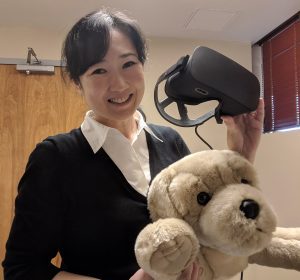
Clark professor Mika Maruyama is using virtual reality equipment to conduct research on virtual pet experiences. Photo by Mika Maruyama
Clark students helped design the study, even auditioning and selecting two dogs to serve as pets, then created virtual reality pet experiences through videography and computer programming. Clark students, including Bynum, recruited 120 participants for the study—out of 240 overall—and collected data from them.
Bynum said he worked a couple of hours each morning, four days a week, collecting data. Each participant was randomly assigned to a data group that determined what activity they performed for 10 minutes. Some interacted with a virtual reality pet. Others watched two- dimensional videos of pets. And others flipped through a photo book of pets.
Resiliency of mosses
Travis Kibota is a biology professor at Clark who conducts his own research and supports and encourages faculty in their research. But once upon a time he was a struggling college student.
He enrolled at University of California Los Angeles and quickly found he didn’t have the academic skills he needed to succeed. A first- generation college student, he wasn’t sure where to turn for help.
“I didn’t know that it was not only okay but the smart thing to do to seek help,” he said.
He had planned to take pre-med courses but found that most of them were in giant lecture halls full of competitive students. Instead, he liked smaller, quirkier biology classes with field trips and hands-on labs.
“I enjoyed being outside and learning about science and biology by looking at things I had seen my whole life but hadn’t noticed,” he said.
Mosses, for example.
“They’re just so tough and they do so much with their little bodies, and they can withstand so much and they’re so resilient,” he said.
Hooked on research
Kibota was accepted into graduate school at the University of Oregon where he worked on his first-ever research project about an endangered moss called the pumice grape fern. Kibota said his research experience affirmed that he was finally on the right track.
“I learned so much more basic biology that I should have learned in my undergraduate classes just by the context,” he said.
He was hooked. He went on to study a unique species of fruit fly found only on the Oregon coast. Part of the insect’s life cycle is hosted by skunk cabbage, a plant that grows in swamps and is inedible to humans.
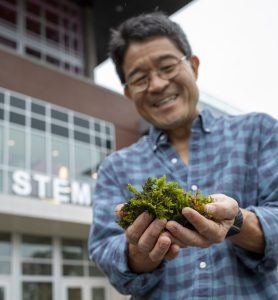
Biology professor Travis Kibota conducts his own research and supports faculty in their research. Mosses are of special interest to him. In graduate school, Kibota studied an endangered moss, called the pumice grape fern. Photo by Jenny Shadley
“I was studying a fruit fly that nobody cared about, on a plant that no one cared about, in soils that no one cared about,” he said.
For his doctorate, Kibota switched to a topic of more obvious relevance: genetic mutations. He studied small mutations that had an almost imperceptible effect on the next generation. Other researchers focused on big mutations that resulted in a drastically different individual organism.
But Kibota was more interested in smaller mutations because they were less likely to get weeded out and could end up having big cumulative effects over generations. It seemed counterintuitive but so did everything Kibota researched. His whole career, he said, has been marked by a willingness to pursue questions overlooked by others.
That points to another reason Kibota enjoyed research so much—the room for creativity and unique insight.
From researcher to teacher
When he finished his doctorate, Kibota looked for a job teaching biology. Clark College offered him a job.
It was a poetic match. At Clark he could offer students the individual attention and support he wished he’d received in undergraduate school.
Kibota figured he would continue at least one of his research projects and maybe involve one or two students. But learning how to teach well took up all his time he found.
“It didn’t seem as good a use of my time as doing something else that could benefit dozens and dozens of my students,” he said.
Kibota’s motivations had changed since he had fallen in love with research during graduate school. But then they changed again.
Kibota served as interim dean of sciences and then worked as a grant writer for Clark. He watched his colleagues—Maruyama and Anitori, for example—conduct research and thought about getting back in the game.
Small world
Then Yale University launched the Small World Initiative, a crowdsourcing approach to research as a radical response to growing antibiotic resistance and the dire need for new antibiotics. He and Anitori joined the initiative, obtained funding and designed Clark’s biology 105 course, Antibiotics Research 1. In it, students are taught to analyze soil samples, searching first for organisms that demonstrate antibiotic activity and then analyzing the genetics of any promising finds for unknown antibiotics.
The idea was revelatory to Kibota.
“This was how you get a whole bunch of students involved in research … you embed the research into a class,” he said.
Since then, Clark has embraced this model of research as a course. Kibota is now working at the state level to develop additional experiences.
He’s also combining his longstanding interests and conducting research on new methods of teaching biology to improve student outcomes. One of his studies was recently accepted for publication by the “Journal of Microbiology & Biology Education.”
Bynum attended Clark as part of the Running Start program. In what would have been his junior and senior years in high school, he studied full time at Clark, working as a research assistant for Maruyama in his final year.
“When I came to Clark, I didn’t know anyone was doing research,” Bynum said.
Bynum is in graduate school for psychology at Gonzaga University where he is conducting more research. And he’s still benefiting from the experience he gained at Clark.
“That kind of experience opens so many doors for you,” he said. “To get that experience at a two-year college is amazing.”
 Written by Lily Raff McCaulou whose writing has appeared in The New York Times, The Atlantic, The Guardian and Rolling Stone. Visit her online at www.lilyrm.com
Written by Lily Raff McCaulou whose writing has appeared in The New York Times, The Atlantic, The Guardian and Rolling Stone. Visit her online at www.lilyrm.com


